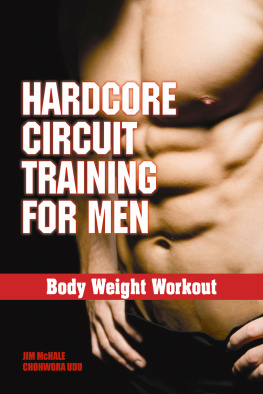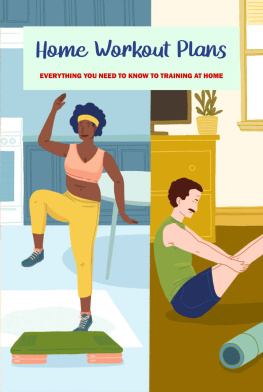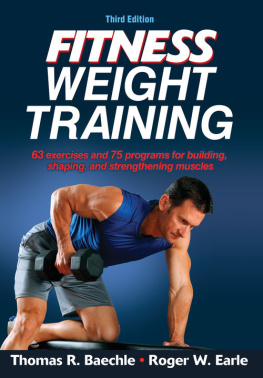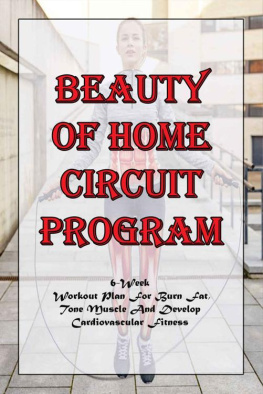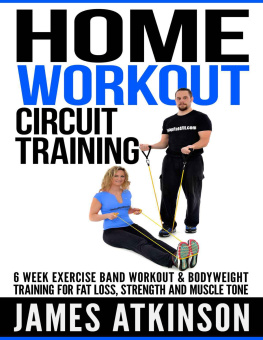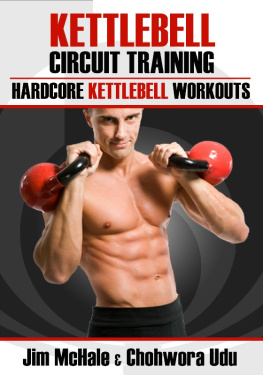HARDCORE
CIRCUIT
TRAINING
FOR MEN
JIM M C HALE
CHOHWORA UDU
Body Weight Workout

Prior to beginning any exercise program, you must consult with your physician. You must also consult your physician before increasing the intensity of your training.
Any application of the recommended material in this book is at the sole risk of the reader, and at the readers discretion. Responsibility of any injuries or other adverse effects resulting from the application of any of the information provided within this book is expressly disclaimed.
www.PriceWorldPublishing.com
Copyright 2010 by Jim McHale and Chohwora Udu. All rights reserved. Neither this book, nor any parts within it may be sold or reproduced in any form without permission.
eISBN: 9781936910397
Table of Contents
Who should use this book?
Put simply, anyone interested in getting superfit, specifically:
- Individuals aspiring to lose weight, tone muscle, or get superfit.
- Athletes who want to work on their conditioning.
- Sports teams or team coaches looking for pre-season conditioning inspiration.
- Personal trainers searching for new ideas for their clients.
- Anyone who is bored with his current workouts and wants to try something new.
Who should not use this book?
Anyone with a serious medical condition, especially a heart condition, should seek specific advice from a medical professional before trying any exercises in this book.
Additionally, anyone who has below average physical fitness should consult medical advice before trying the exercises in this book.
Who are the authors of this book?
Jim McHale is an endurance athlete and ex-amateur boxer with more than ten years experience designing gym circuits. He has experience competing in Ironman Triathlon and other long-distance events including the 190 kilometer Libyan Challenge Desert Race. Jim has been associated with the fitness industry for more than 15 years.
Chohwora Udu has more than thirty years experience in boxing as both a professional fighter and as a coach. He has trained both professional and amateur boxers and he holds YMCA qualifications in gym instruction and circuit training. As a fitness instructor, Chohwora specializes in the areas of muscular endurance, strength, and flexibility.
A note on training intensity
The circuit in this book is meant to be hard and intense. If your heart isnt beating fast and youre not sweating, then youre doing something wrong.
If you can afford it, buy a heart rate monitor. This will tell you exactly how hard you are working and help you keep track of which heart rate zone you are working in. The most effective zone for overall cardiovascular fitness is between 70 percent and 80 percent of your working heart rate. Working in this zone generates the best results.
How do I calculate my working heart rate?
Roughly speaking, your maximum heart rate is 220 minus your age.
The formula for your working heart rate is:
Your maximum heart rate minus your resting heart rate equals your working heart rate.
Lets look at an example for a twenty-five-year-old athlete:
Maximum heart rate:
220 25 = 195 beats per minute (bpm).
Resting heart rate: 55 bpm.
Working heart rate:
195 (maximum heart rate) 55 (resting heart rate = 140 bpm (working heart rate)
Now, that we know your working heart rate, we can figure the best zone for trainingwhich is between 70 percent and 80 percent of your working heart rate. This is important because you want to be careful not to go too far over your target zone.
Using the example above, lets calculate your target training zone by adding 80 percent of your working heart rate to your resting heart rate:
140 bpm x 0.8 (80% of working heart rate) + 55 (resting heart rate) = 167 bpm (target training zone).
So a twenty-five-year-old athlete with a resting heart rate of 55 beats per minute should be aiming to exercise at around 167 beats per minute.
What this book cannot do for you
There are no magic shortcuts to getting fit. You will have to push your body hard. However, that doesnt mean you need to blindly follow this book without any thought for timing of exercise, nutrition, or rest. Think of exercise as just one of the components you need to get fit.
Ideally, get lots of rest and sleep. Do not train every day; your body needs time to recover after vigorous exercise.
Think about training in pairs or a small group. You will motivate each other, and it helps prevent cheating or poor technique during exercises. If you can afford it, exercise with a qualified personal trainer.
Nutrition
Nutrition is a topic all by itself, and we could easily fill a separate book on the subject if we went into any detail. In this book, we are concentrating on exercise so we will only briefly touch on nutrition.
Nutrition is an absolutely essential part of getting fit, but what works for one person may not necessarily work for someone else because we all burn calories at different rates. That said, there are some general rules of thumb to follow:
- Eat little and often. Have several small meals throughout the day whenever you feel hungry rather than a few big meals. Try eating meals around the size of your hand rather than filling the whole plate with food.
- Eat after exercise. If youve just burned a load of calories exercising, then your body will be looking to replace those calories. If you dont eat fairly soon, your body will be likely to start burning muscle to use as fuel, which defeats the whole purpose of exercising in the first place.
- Raw food is better than cooked food. When you cook food, you destroy some of the nutrients inside it. Try eating raw vegetables, fruit, raw fish (sushi), etc. Obviously DONT eat ALL food raw for health reasons.
- If you want advice and tips on nutrition, take a look at: www.mensfitness.com/nutrition and www.menshealth.co.uk/Nutrition/landing .
Some Useful Resources
There is a tremendous amount of useful information about exercise and nutrition on the Web. Here is a selection of some of our favorite Web sites:
- www.dailyburn.com Fitness site for detailed tracking of workouts and nutrition, online accountability, and motivation. Free to sign up for an account.
- www.mensfitness.com Web site for monthly fitness magazine featuring good advice on fitness, weight training, and nutrition.
- www.sportsworkout.com/etraining Excellent online personal training site where you can train directly with fitness expert Rob Price.
- www.mapmyrun.com Create/share or search for runs in your area.
- www.gimme20.com Good online resource for creating and finding gym workouts. Offers a volume of details, pictures, and explanations.
- www.youtube.com Search for thousands of fitness videos here; great for picking up tips on technique or for getting new exercise ideas.
Warming Up
The basic idea behind warming up is to prepare your body, particularly your muscles, for physical activity.
A warmup is therefore usually performed directly before exercise and involves some kind of low-intensity activity. Jogging is ideal. It increases your heart rate and generally prepares you for what is to come.

